A Study of the Relationship between Human Behavior and Urban Design during the Winter in a High-Snowfall Urban Area
Abstract
1. Introduction
2. Literature Review
2.1. Research on Urban Public Space
2.1.1. Spatial Design and People in Public Spaces
2.1.2. Environment and Human Comfort in Public Spaces
2.1.3. Environment and Human Behavior in Public Spaces
2.2. Research on Urban Public Space in Regions with Cold Climates
2.2.1. Spatial Design and the Environments of Public Spaces in Regions with Cold Climates
2.2.2. Environments and Human Comfort in Public Spaces in Regions with Cold Climates
2.2.3. Environments and Human Behavior in Public Spaces in Regions with Cold Climates
3. Materials and Methods
3.1. Target Area: AKAPLA Plaza in Downtown Sapporo
3.2. Field Survey Methods
4. Results
4.1. The Outdoor Environment on the Days of the Survey
4.2. An Analysis of the Number of Pedestrians
4.3. Analysis of the Number of People Engaging in Staying Behavior
4.4. Analysis of Walking Paths and the Location of Idling Activities
4.5. Design Policies
4.5.1. Relationship between Temperature and Usage Behavior
4.5.2. PATH: Low Snowfall Design That Reduces Barriers to Walking Behavior
4.5.3. STORAGE: Snow Design That Encourages Staying Behavior
4.5.4. APPROACH: Control of Snow Accumulation to Promote Staying Behavior
5. Discussion
6. Conclusions
Author Contributions
Funding
Institutional Review Board Statement
Informed Consent Statement
Data Availability Statement
Acknowledgments
Conflicts of Interest
References
- Jacobs, A.; Appleyard, D. Toward an urban design manifesto. J. Am. Plann Assoc. 1987, 53, 112–120. [Google Scholar] [CrossRef]
- Jacobs, A.B. Looking at Cities; Harvard University Press: Cambridge, MA, USA; London, UK, 1985. [Google Scholar] [CrossRef]
- Gehl, J. Life between Buildings; Island Press: Washington, DC, USA, 1971. [Google Scholar]
- Gehl, J. Cities for People; Island Press: Washington, DC, USA, 2013. [Google Scholar]
- Gehl, J.; Svarre, B. (Eds.) Counting, mapping, tracking and other tools. In How to Study Public Life; Island Press/Center for Resource Economics: Washington, DC, USA, 2013; pp. 21–36. [Google Scholar]
- Sim, D. Soft City: Building Density for Everyday Life; Island Press: Washington, DC, USA, 2019. [Google Scholar]
- Lynch, K. The Image of the City; MIT Press: Cambridge, MA, USA, 1964. [Google Scholar]
- Alexander, C.; Ishikawa, S.; Silverstein, M. A Pattern Language: Towns, Buildings, Construction; Oxford University Press: Oxford, UK, 1977. [Google Scholar]
- Marcus, C.C.; Francis, C. (Eds.) People Places: Design Guidlines for Urban Open Space, 2nd ed.; John Wiley and Sons: Hoboken, NJ, USA, 1997. [Google Scholar]
- Koohsari, M.J.; Mavoa, S.; Villanueva, K.; Sugiyama, T.; Badland, H.; Kaczynski, A.T.; Owen, N.; Giles-Corti, B. Public Open space, physical activity, urban design and public health: Concepts, methods and research agenda. Health Place 2015, 33, 75–82. [Google Scholar] [CrossRef]
- Chen, Y.; Liu, T.; Liu, W. Increasing the use of large-scale public open spaces: A case study of the North Central axis square in Shenzhen, China. Habitat. Int. 2016, 53, 66–77. [Google Scholar] [CrossRef]
- Sun, X.; Wang, L.; Wang, F.; Soltani, S. Behaviors of seniors and impact of spatial form in small-scale public spaces in Chinese old city zones. Cities 2020, 107, 102894. [Google Scholar] [CrossRef]
- Motomura, M.; Koohsari, M.J.; Lin, C.Y.; Ishii, K.; Shibata, A.; Nakaya, T.; Kaczynski, A.T.; Veitch, J.; Oka, K. Associations of public open space attributes with active and sedentary behaviors in dense urban areas: A systematic review of observational studies. Health Place 2022, 75, 102816. [Google Scholar] [CrossRef]
- Vidal, D.G.; Teixeira, C.P.; Fernandes, C.O.; Olszewska-guizzo, A.; Dias, R.C.; Vilaça, H.; Barros, N.; Maia, R.L. Patterns of human behaviour in public urban green spaces: On the influence of users’ profiles, surrounding environment, and space design. Urban. Green. 2022, 74, 127668. [Google Scholar] [CrossRef]
- Pinto, L.V.; Ferreira, C.S.S.; Pereira, P. Temporal and spatial differences in human activities performed in urban green spaces of Vilnius (Lithuania). Geogr. Sustain. 2024, 5, 302–317. [Google Scholar] [CrossRef]
- Pietilä, M.; Neuvonen, M.; Borodulin, K.; Korpela, K.; Sievänen, T.; Tyrväinen, L. Relationships between exposure to urban green spaces, physical activity and self-rated health. J. Outdoor Recreat. Tour. 2015, 10, 44–54. [Google Scholar] [CrossRef]
- Hadavi, S.; Kaplan, R. Neighborhood satisfaction and use patterns in urban public outdoor spaces: Multidimensionality and two-way relationships. Urban. Green. 2016, 19, 110–122. [Google Scholar] [CrossRef]
- Liu, H.; Li, F.; Li, J.; Zhang, Y. The relationships between urban parks, residents’ physical activity, and mental health benefits: A case study from Beijing, China. J. Environ. Manag. 2017, 190, 223–230. [Google Scholar] [CrossRef]
- Do, D.T.; Cheng, Y.; Shojai, A.; Chen, Y. Public park behaviour in Da Nang: An investigation into how open space is used. Front. Archit. Res. 2019, 8, 454–470. [Google Scholar] [CrossRef]
- Teixeira, C.F.B. Green space configuration and its impact on human behavior and URBAN environments. Urban. Clim. 2021, 35, 100746. [Google Scholar] [CrossRef]
- Balai Kerishnan, P.; Maruthaveeran, S. Factors contributing to the usage of pocket parks—A review of the evidence. Urban. Green. 2021, 58, 126985. [Google Scholar] [CrossRef]
- Reyes-Riveros, R.; Altamirano, A.; De La Barrera, F.; Rozas-Vásquez, D.; Vieli, L.; Meli, P. Linking public urban green spaces and human well-being: A systematic review. Urban. Green. 2021, 61, 127105. [Google Scholar] [CrossRef]
- Hematian, H.; Ranjbar, E. Evaluating urban public spaces from mental health point of view: Comparing pedestrian and car-dominated streets. J. Transp. Health 2022, 27, 101532. [Google Scholar] [CrossRef]
- Arens, E.; Bosselmann, P. Wind, sun and temperature—Predicting the thermal comforf of people in outdoor spaces. Build. Environ. 1989, 24, 315–320. [Google Scholar] [CrossRef]
- Bosselmann, P.; Flores, J.; Gray, W. Sun, Wind, and Comfort: A Study of Open Spaces and Sidewalks in Four Downtown Areas Publication Date; Institute of Urban and Regional Development: Berkeley, CA, USA, 1984. [Google Scholar]
- Bosselmann, P.; Dunker, K. Sun, Wind, and Pedestrian Comfort: A Study of Toronto’s Central Area; Sustainability, Whole Building Energy and Other Topics; University of California: Berkeley, CA, USA, 1990; Available online: http://escholarship.org/uc/item/0165c77h (accessed on 5 May 2024).
- Bourbia, F.; Boucheriba, F. Impact of street design on urban microclimate for semi arid climate (Constantine). Renew. Energy 2010, 35, 343–347. [Google Scholar] [CrossRef]
- Shahrestani, M.; Yao, R.; Luo, Z.; Turkbeyler, E.; Davies, H. A field study of urban microclimates in London. Renew. Energy 2015, 73, 3–9. [Google Scholar] [CrossRef]
- Andreou, E. The effect of urban layout, street geometry and orientation on shading conditions in urban canyons in the Mediterranean. Renew. Energy 2014, 63, 587–596. [Google Scholar] [CrossRef]
- Spagnolo, J.; de Dear, R. A field study of thermal comfort in outdoor and semi-outdoor environments in subtropical Sydney Australia. Build. Environ. 2003, 38, 721–738. [Google Scholar] [CrossRef]
- Hwang, R.-L.; Lin, T.-P.; Matzarakis, A. Seasonal effects of urban street shading on long-term outdoor thermal comfort. Build. Environ. 2011, 46, 863–870. [Google Scholar] [CrossRef]
- Höppe, P. The physiological equivalent temperature—A universal index for the biometeorological assessment of the thermal environment. Int. J. Biometeorol. 1999, 43, 71–75. [Google Scholar] [CrossRef]
- Shimazaki, Y.; Yoshida, A.; Suzuki, R.; Kawabata, T.; Imai, D.; Kinoshita, S. Application of human thermal load into unsteady condition for improvement of outdoor thermal comfort. Build. Environ. 2011, 46, 1716–1724. [Google Scholar] [CrossRef]
- Li, K.; Zhang, Y.; Zhao, L. Outdoor thermal comfort and activities in the urban residential community in a humid subtropical area of China. Energy Build. 2016, 133, 498–511. [Google Scholar] [CrossRef]
- Ma, X.; Tian, Y.; Du, M.; Hong, B.; Lin, B. How to design comfortable open spaces for the elderly? Implications of their thermal perceptions in an urban park. Sci. Total Environ. 2021, 768, 144985. [Google Scholar] [CrossRef]
- Darbani, E.S.; Rafieian, M.; Parapari, D.M.; Guldmann, J.M. Urban design strategies for summer and winter outdoor thermal comfort in arid regions: The case of historical, contemporary and modern urban areas in Mashhad, Iran. Sustain. Cities Soc. 2023, 89, 104339. [Google Scholar] [CrossRef]
- Lenzholzer, S.; Klemm, W.; Vasilikou, C. Qualitative methods to explore thermo-spatial perception in outdoor urban spaces. Urban. Clim. 2018, 23, 231–249. [Google Scholar] [CrossRef]
- Li, K.; Liu, M. Combined influence of multi-sensory comfort in winter open spaces and its association with environmental factors: Wuhan as a case study. Build. Environ. 2024, 248, 111037. [Google Scholar] [CrossRef]
- Shooshtarian, S. Theoretical dimension of outdoor thermal comfort research. Sustain. Cities Soc. 2019, 47, 101495. [Google Scholar] [CrossRef]
- Lai, D.; Lian, Z.; Liu, W.; Guo, C.; Liu, W.; Liu, K.; Chen, Q. A comprehensive review of thermal comfort studies in urban open spaces. Sci. Total Environ. 2020, 742, 140092. [Google Scholar] [CrossRef]
- Thorsson, S.; Lindqvist, M.; Lindqvist, S. Thermal bioclimatic conditions and patterns of behaviour in an urban park in Göteborg, Sweden. Int. J. Biometeorol. 2004, 48, 149–156. [Google Scholar] [CrossRef]
- Zacharias, J.; Stathopoulos, T.; Wu, H. Spatial behavior in San Francisco’s plazas: The effects of microclimate, other people, and environmental design. Environ. Behav. 2004, 36, 638–658. [Google Scholar] [CrossRef]
- Nikolopoulou, M.; Lykoudis, S. Use of outdoor spaces and microclimate in a Mediterranean urban area. Build. Environ. 2007, 42, 3691–3707. [Google Scholar] [CrossRef]
- Lenzholzer, S.; Koh, J. Immersed in microclimatic space: Microclimate experience and perception of spatial configurations in Dutch squares. Landsc. Urban. Plan. 2010, 95, 1–15. [Google Scholar] [CrossRef]
- Bosselmann, P. Urban Transformation: Understanding City Form and Design; Island Press: Washington, DC, USA, 2012. [Google Scholar]
- Chen, L.; Ng, E. Outdoor thermal comfort and outdoor activities: A review of research in the past decade. Cities 2012, 29, 118–125. [Google Scholar] [CrossRef]
- Huang, K.T.; Lin, T.-P.; Lien, H.C. Investigating thermal comfort and user behaviors in outdoor spaces: A seasonal and spatial perspective. Adv. Meteorol. 2015, 2015, 423508. [Google Scholar] [CrossRef]
- Sharifi, E.; Sivam, A.; Boland, J. Spatial and activity preferences during heat stress conditions in Adelaide: Towards increased adaptation capacity of the built environment. Procedia Eng. 2017, 180, 955–965. [Google Scholar] [CrossRef]
- Han, S.; Song, D.; Xu, L.; Ye, Y.; Yan, S.; Shi, F.; Zhang, Y.; Liu, X.; Du, H. Behaviour in public open spaces: A systematic review of studies with quantitative research methods. Build. Environ. 2022, 223, 109444. [Google Scholar] [CrossRef]
- Ebrahimabadi, S.; Nilsson, K.L.; Johansson, C. The problems of addressing microclimate factors in urban planning of the subarctic regions. Environ. Plan. B Plan. Des. 2015, 42, 415–430. [Google Scholar] [CrossRef]
- Pressman, N. Northern Cityscape: Linking Design to Climate; Winter Cities Association: Norilsk, Russia, 1995. [Google Scholar]
- Stout, M.; Collins, D.; Stadler, S.L.; Soans, R.; Sanborn, E.; Summers, R.J. ‘Celebrated, Not Just Endured’: Rethinking winter cities. Geogr. Compass 2018, 12, e12379. [Google Scholar] [CrossRef]
- Stout, M.; Collins, D.; Evans, J. ‘We Embrace Winter Here’: Celebrating place in winter cities. Can. Geogr. Géographies Can. 2022, 66, 728–740. [Google Scholar] [CrossRef]
- Collymore, P.; Erskine, R. The Architecture of Ralph Erskine; Wiley: Hoboken, NJ, USA, 1995. [Google Scholar]
- Pressman, N.; Association, W.C. Shaping Cities for Winter: Climatic Comfort and Sustainable Design; Winter Cities Association: Norilsk, Russia, 2004. [Google Scholar]
- Setoguchi, T. A case study on the urban design guidelines for winter cities and the role of advisory design panel in prince George City, Canada (urban planning). AIJ J. Technol. Des. 2006, 12, 337–342. [Google Scholar] [CrossRef]
- Edmonton. Winter City Design Guidelines; The Energetic City, Urban Systems: Fort St. John, BC, Canada, 2016; pp. 1–93. Available online: https://www.edmonton.ca/city_government/documents/PDF/WinterCityDesignGuidelines_draft.pdf (accessed on 5 May 2024).
- Chen, L.; Wen, Y.; Zhang, L.; Xiang, W.-N. Studies of thermal comfort and space use in an urban park square in cool and cold seasons in Shanghai. Build. Environ. 2015, 94, 644–653. [Google Scholar] [CrossRef]
- Lai, D.; Guo, D.; Hou, Y.; Lin, C.; Chen, Q. Studies of outdoor thermal comfort in northern China. Build. Environ. 2014, 77, 110–118. [Google Scholar] [CrossRef]
- Eliasson, I.; Knez, I.; Westerberg, U.; Thorsson, S.; Lindberg, F. Climate and behaviour in a Nordic city. Landsc. Urban. Plan. 2007, 82, 72–84. [Google Scholar] [CrossRef]
- Ebrahimabadi, S.; Johansson, C.; Rizzo, A.; Nilsson, K. Microclimate assessment method for urban design—A case study in subarctic climate. Urban. Des. Int. 2018, 23, 116–131. [Google Scholar] [CrossRef]
- Zhu, X.; Zhang, Y.; Luo, Y.Y.; Zhao, W. Natural or artificial? Exploring perceived restoration potential of community parks in winter city. Urban. Green. 2023, 79, 127808. [Google Scholar] [CrossRef]
- Paukaeva, A.A.; Setoguchi, T.; Watanabe, N.; Luchkova, V.I. Temporary design on public open space for improving the pedestrian’s perception using social media images in winter cities. Sustainability 2020, 12, 6062. [Google Scholar] [CrossRef]
- Paukaeva, A.A.; Setoguchi, T.; Luchkova, V.I.; Watanabe, N.; Sato, H. Impacts of the temporary urban design on the people’s behavior—The case study on the winter city Khabarovsk, Russia. Cities 2021, 117, 103303. [Google Scholar] [CrossRef]
- Chapman, D. Urban Design of Winter Cities: Winter Season Connectivity for Soft Mobility. Ph.D. Thesis, Luleå Tekniska Universitet, Luleå, Sweden, 2018. Available online: https://urn.kb.se/resolve?urn=urn:nbn:se:ltu:diva-70507 (accessed on 5 May 2024).
- Japan Meteorological Agency. Download Historical Weather Data; Japan Meteorological Agency, n.d. Available online: https://www.data.jma.go.jp/risk/obsdl/index.php (accessed on 30 October 2023).
- Watanabe, N.; Setoguchi, T.; Maeda, K.; Iwakuni, D.; Guo, Z.; Tsutsumi, T. Sustainable block design process for high-rise and high-density districts with snow and wind simulations for winter cities. Sustainability 2017, 9, 2132. [Google Scholar] [CrossRef]

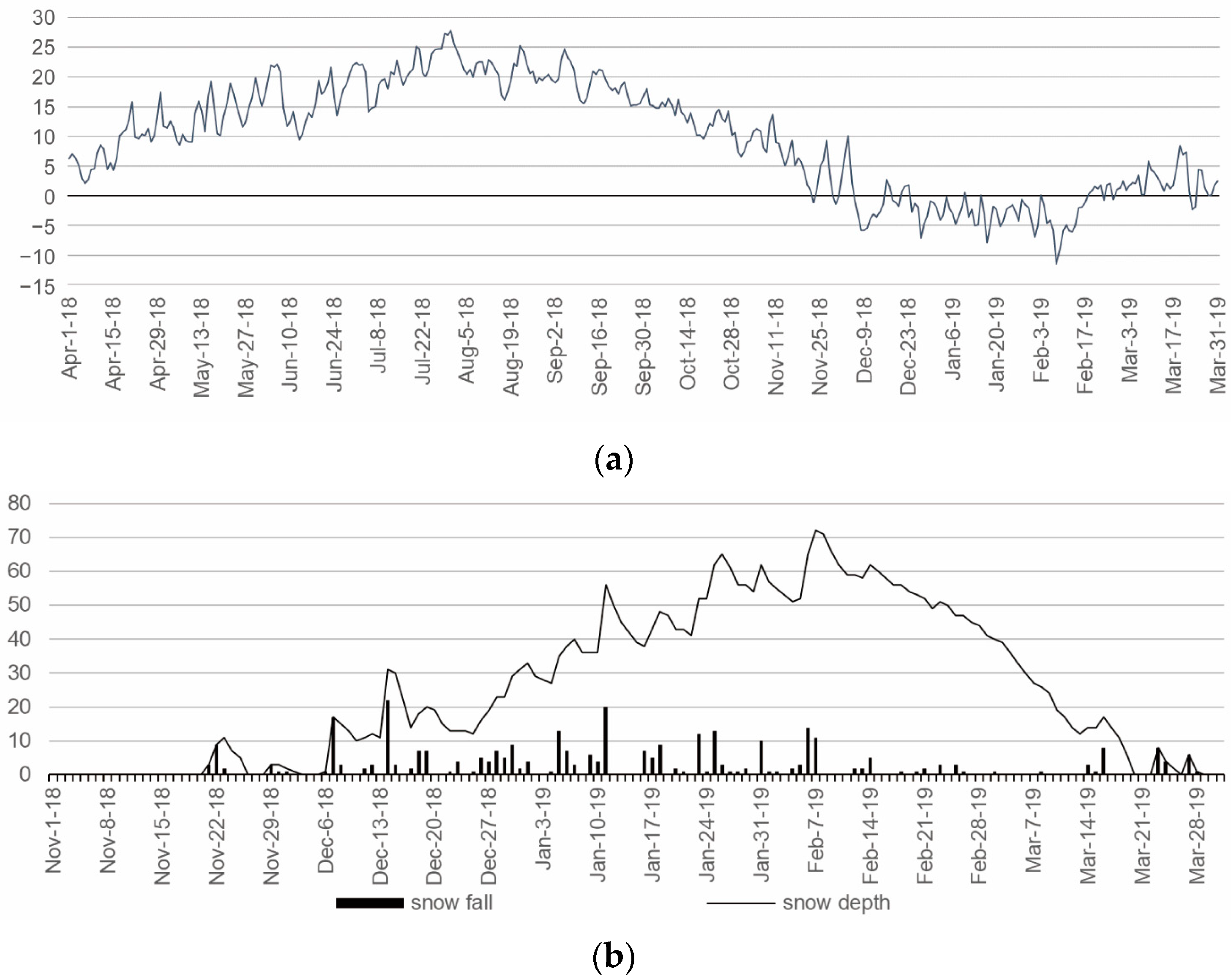
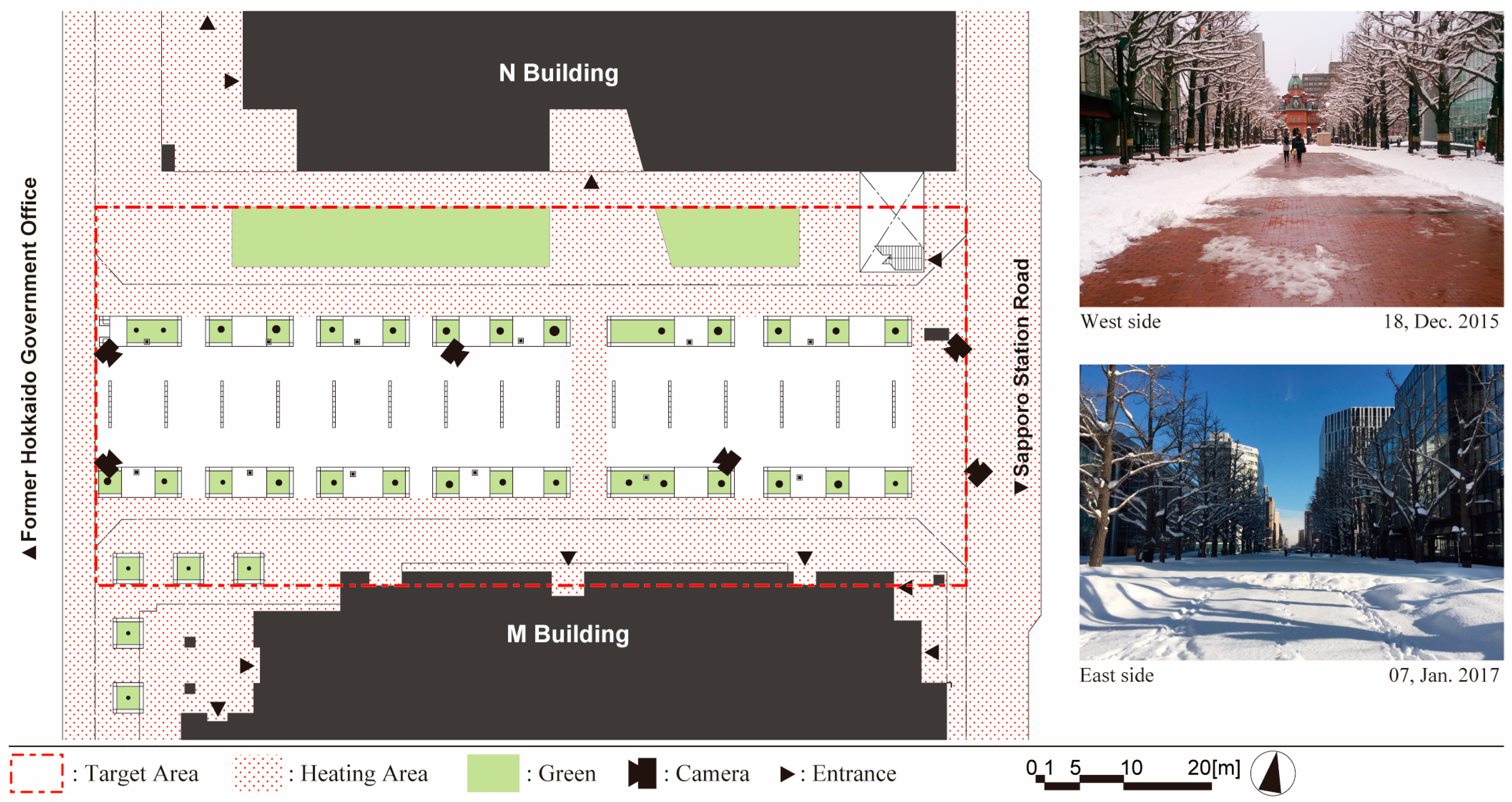


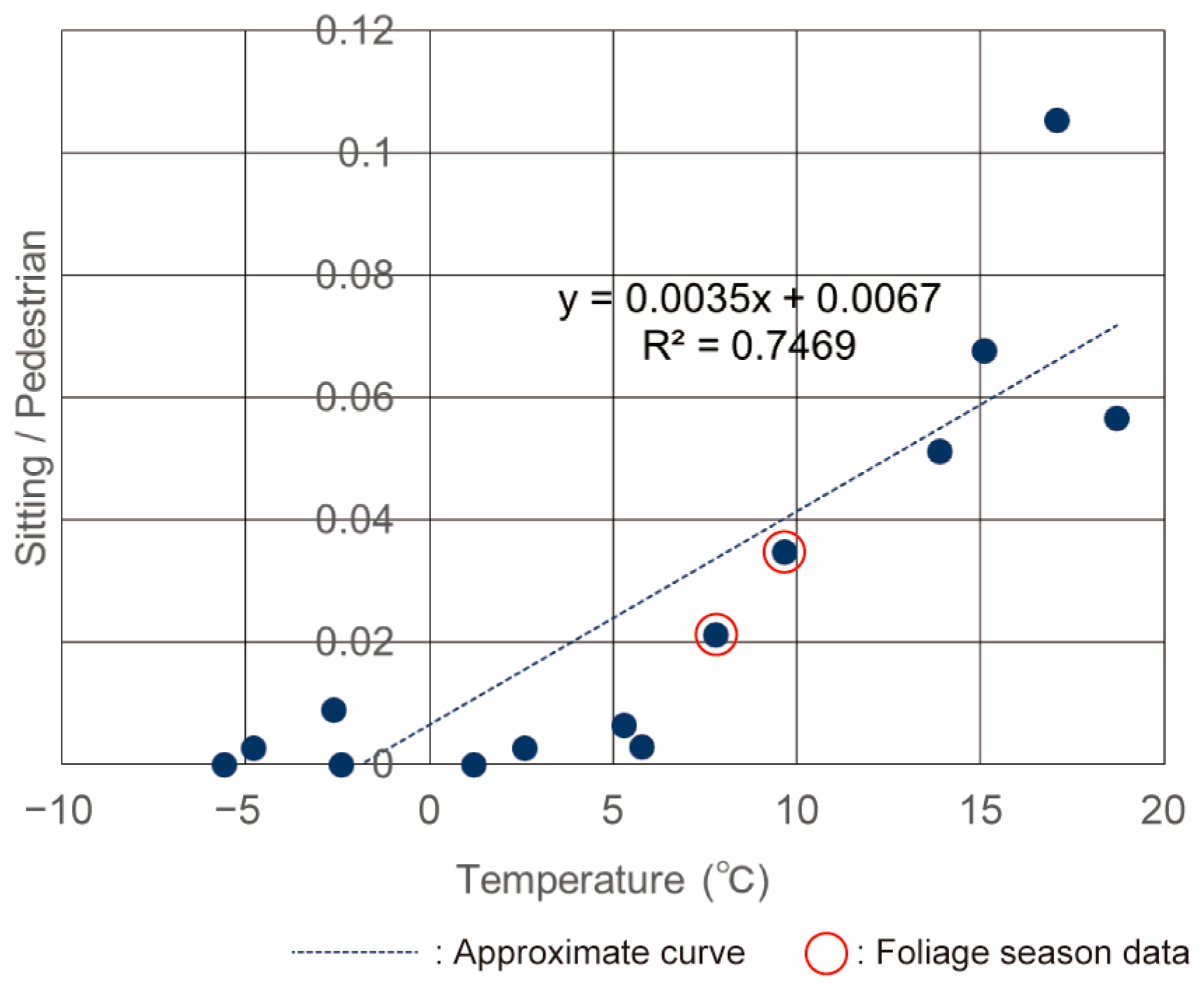
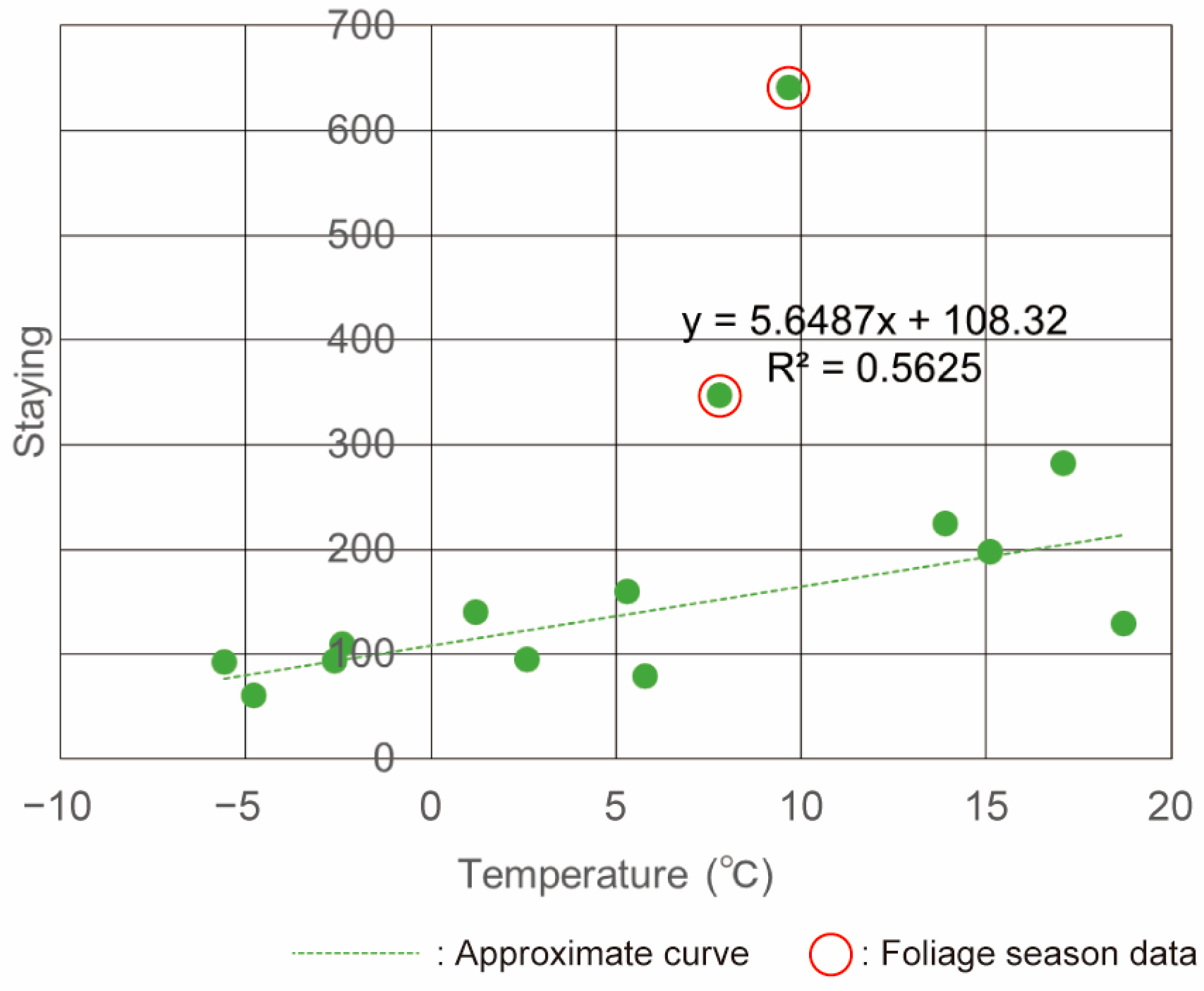
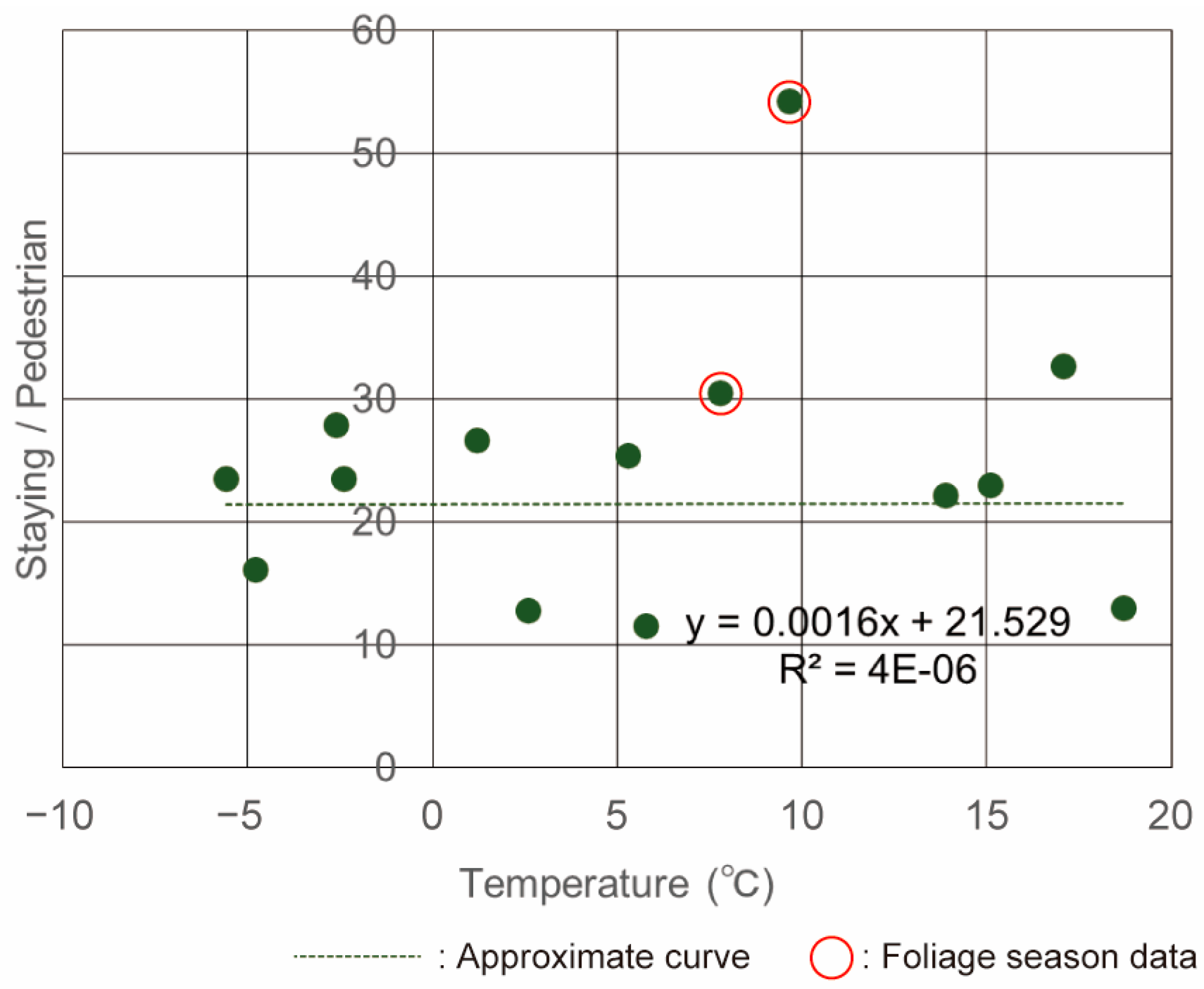
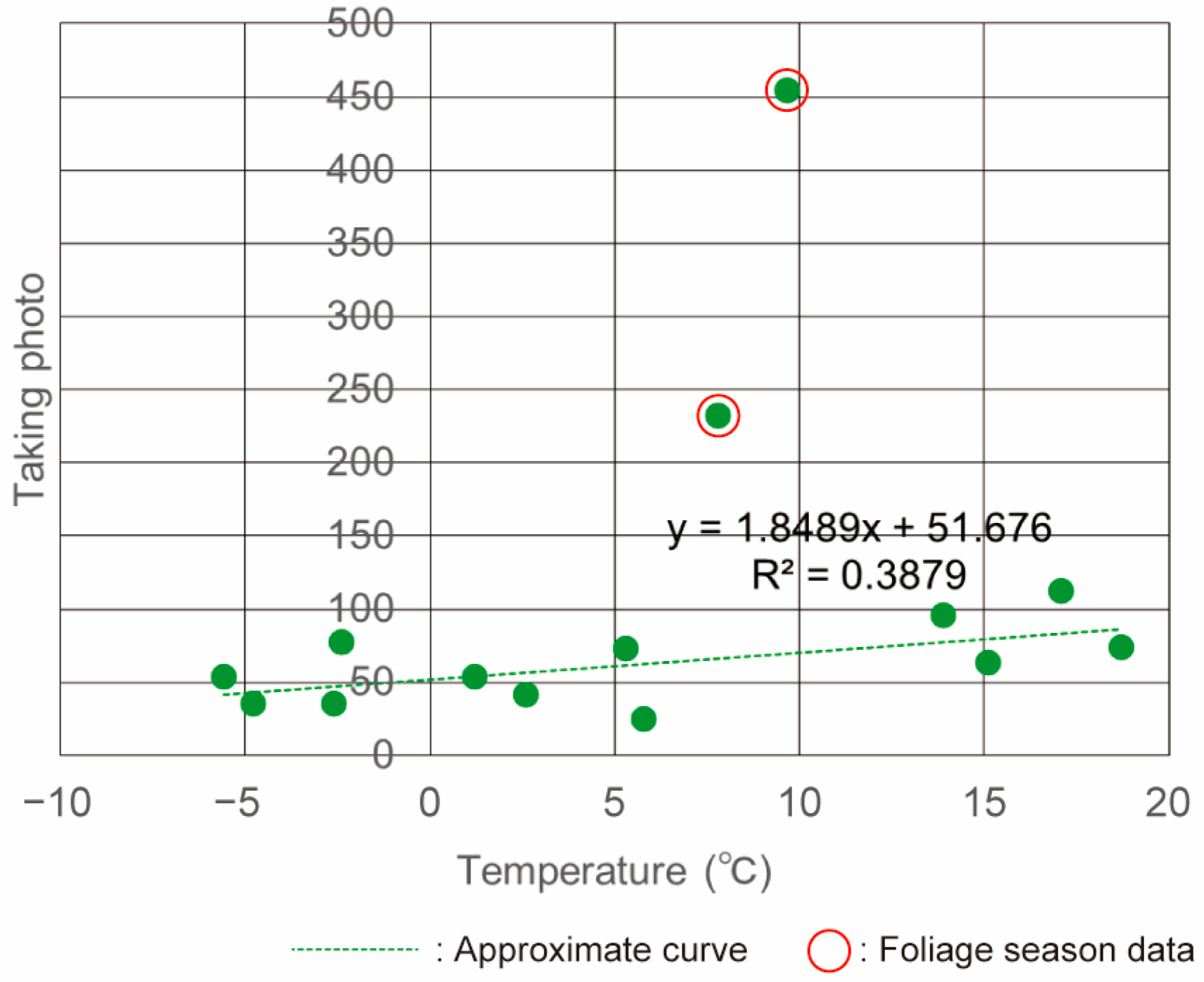


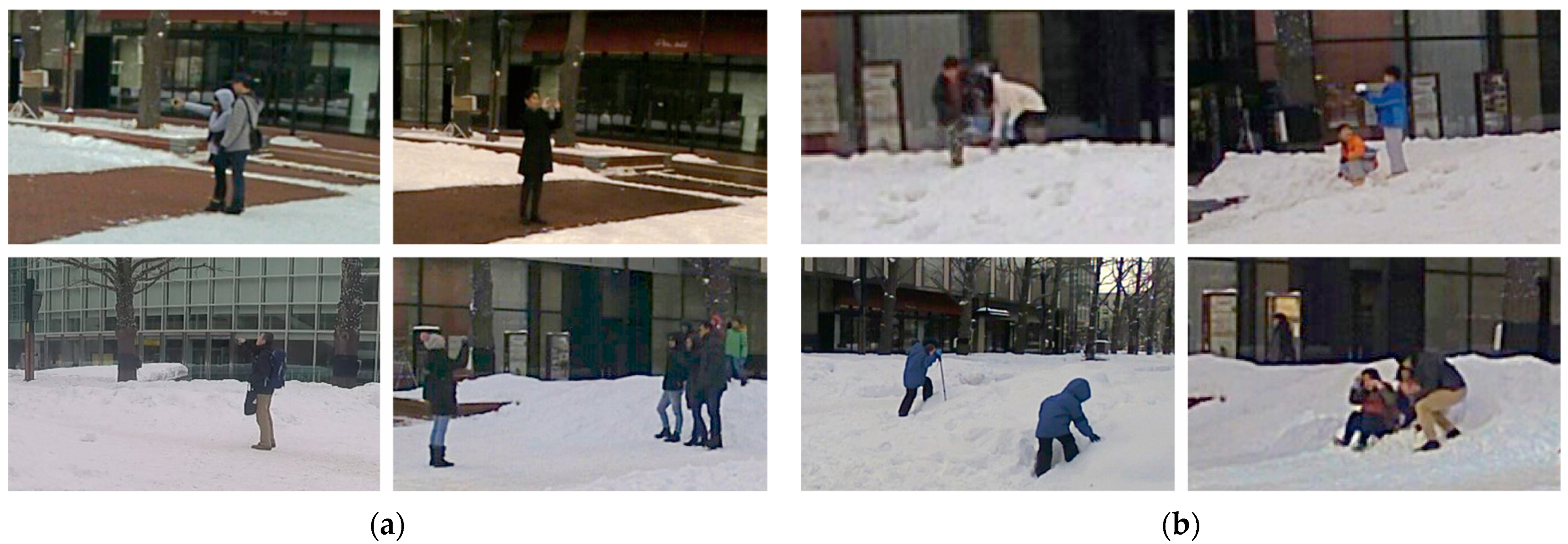
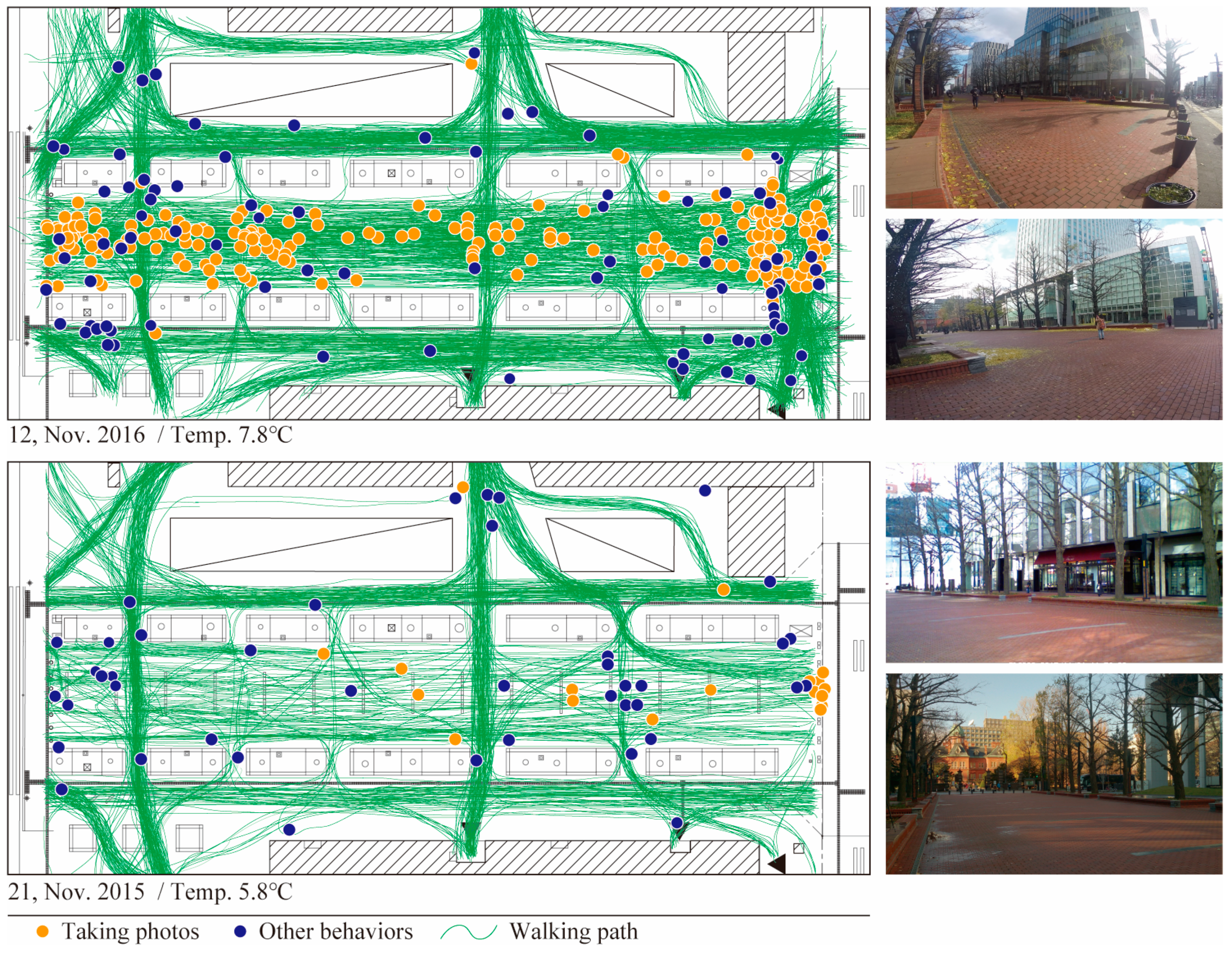
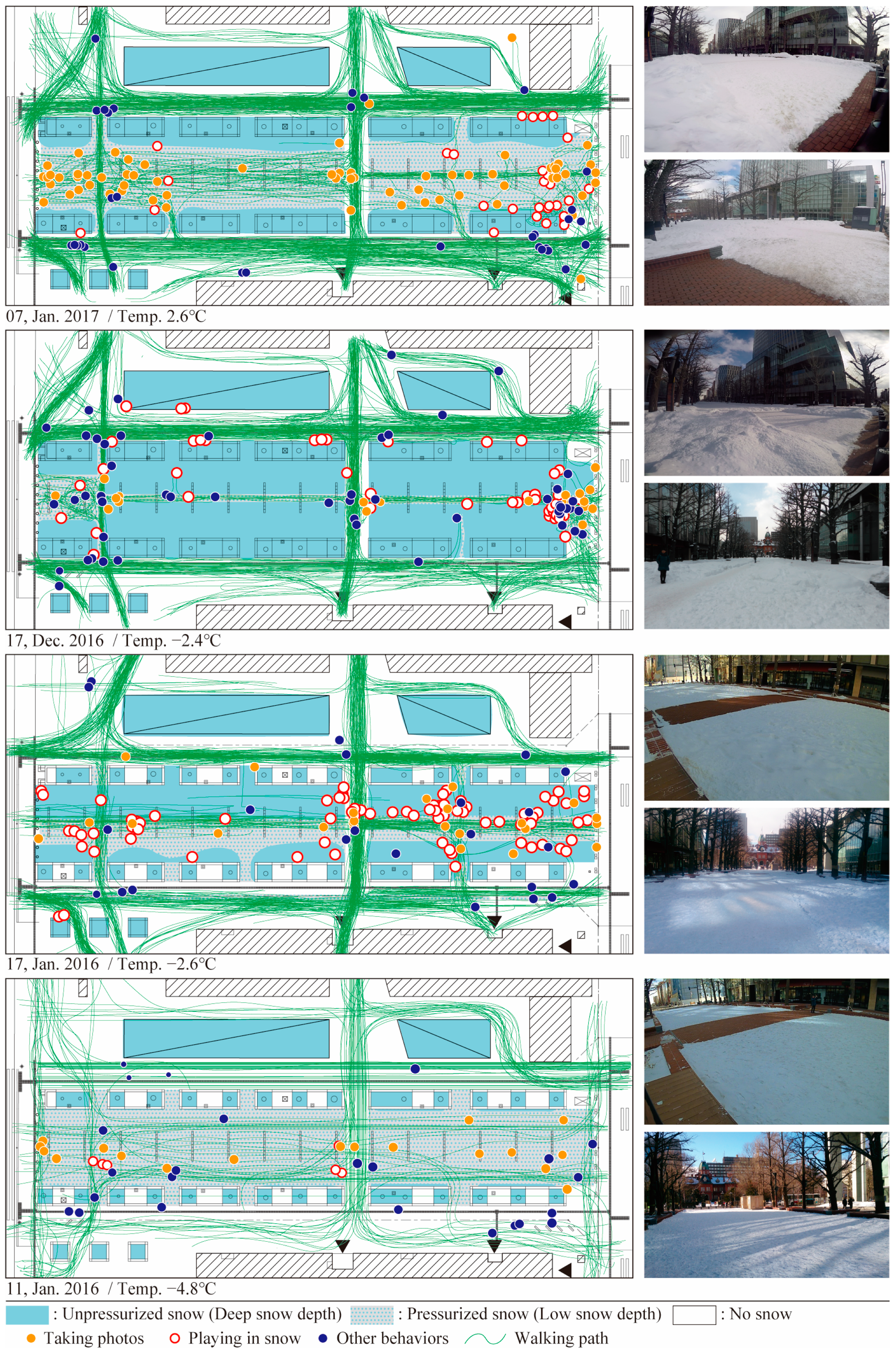
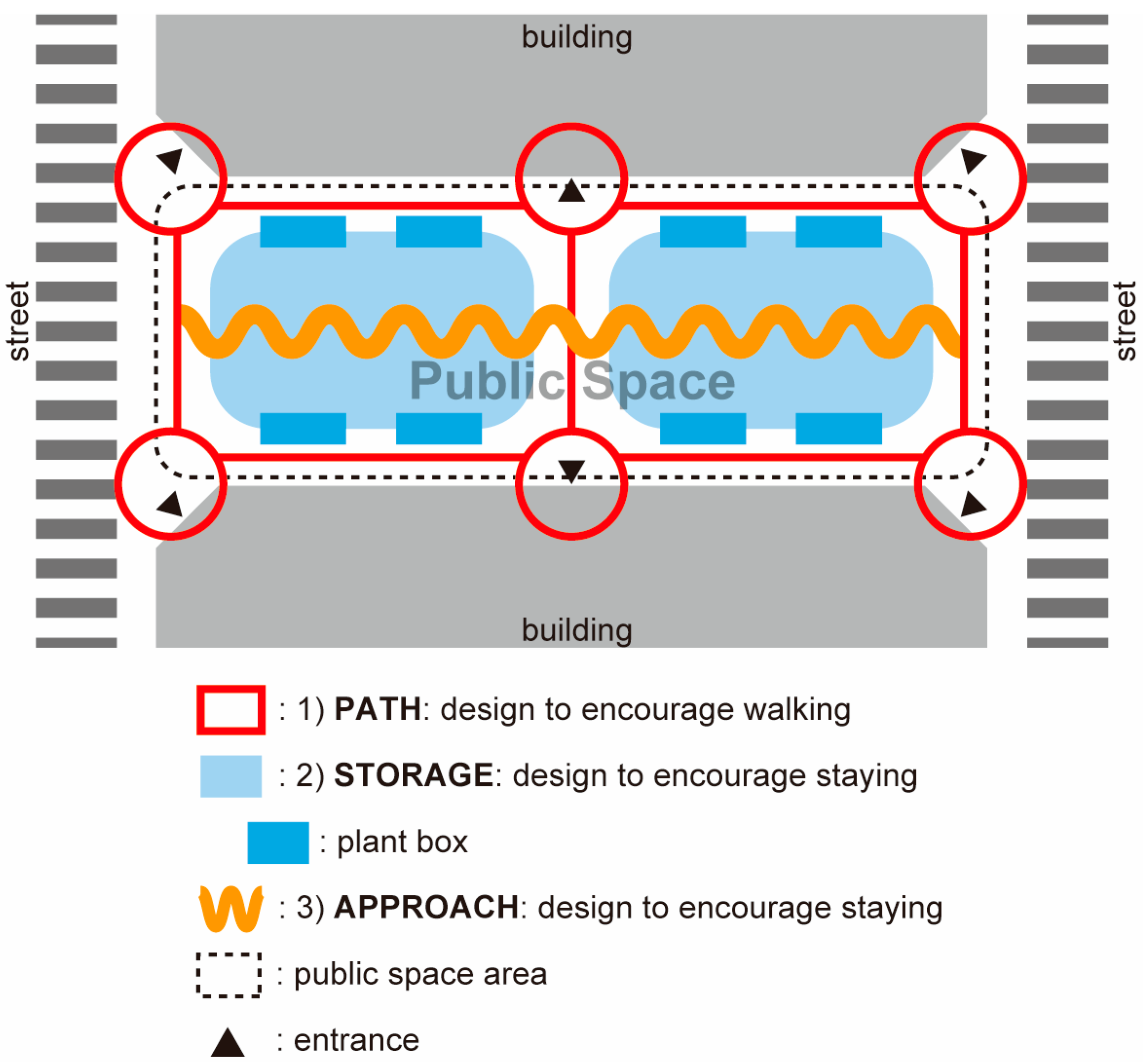
| Kinds of Human Behavior | Survey Items | |
|---|---|---|
| (a) Sitting | Number of people sitting | |
| (b) Walking | Number of pedestrians | |
| Walking paths | ||
| (c) Staying | (c1) Taking photos | Number of groups |
| Location of the photos taken | ||
| (c2) Playing in the snow | Number of groups | |
| Location where people played in the snow | ||
| (c3) Others | Number of groups | |
| Location of staying | ||
| Date | Temp. | Average Wind Speed (m/s) | Solar Radiation (MJ/m2) | Humidity (%) | Snow Cover |
|---|---|---|---|---|---|
| 10 October 2015 | 17.1 | 1.6 | 1.25 | 44 | |
| 21 November 2015 | 5.8 | 4.4 | 1.41 | 64 | |
| 27 December 2015 | −5.6 | 6.1 | 0.91 | 44 | ✓ |
| 11 January 2016 | −4.8 | 5.7 | 1.73 | 42 | ✓ |
| 17 January 2016 | −2.6 | 1.3 | 1.64 | 58 | ✓ |
| 24 April 2016 | 13.9 | 5.5 | 1.90 | 34 | |
| 8 May 2016 | 18.7 | 8.1 | 3.47 | 19 | |
| 12 November 2016 | 7.8 | 0.8 | 1.14 | 71 | |
| 17 December 2016 | −2.4 | 4.8 | 0.95 | 48 | ✓ |
| 7 January 2017 | 2.6 | 0.8 | 1.20 | 51 | ✓ |
| 18 March 2017 | 5.3 | 5.2 | 2.61 | 43 | ✓ |
| 29 April 2017 | 15.1 | 4.9 | 2.84 | 45 | |
| 20 January 2018 | 1.2 | 4.1 | 1.63 | 40 | ✓ |
| 3 November 2019 | 9.7 | 4.9 | 1.96 | 52 |
Disclaimer/Publisher’s Note: The statements, opinions and data contained in all publications are solely those of the individual author(s) and contributor(s) and not of MDPI and/or the editor(s). MDPI and/or the editor(s) disclaim responsibility for any injury to people or property resulting from any ideas, methods, instructions or products referred to in the content. |
© 2024 by the authors. Licensee MDPI, Basel, Switzerland. This article is an open access article distributed under the terms and conditions of the Creative Commons Attribution (CC BY) license (https://creativecommons.org/licenses/by/4.0/).
Share and Cite
Watanabe, N.; Setoguchi, T. A Study of the Relationship between Human Behavior and Urban Design during the Winter in a High-Snowfall Urban Area. Sustainability 2024, 16, 3983. https://doi.org/10.3390/su16103983
Watanabe N, Setoguchi T. A Study of the Relationship between Human Behavior and Urban Design during the Winter in a High-Snowfall Urban Area. Sustainability. 2024; 16(10):3983. https://doi.org/10.3390/su16103983
Chicago/Turabian StyleWatanabe, Norihiro, and Tsuyoshi Setoguchi. 2024. "A Study of the Relationship between Human Behavior and Urban Design during the Winter in a High-Snowfall Urban Area" Sustainability 16, no. 10: 3983. https://doi.org/10.3390/su16103983
APA StyleWatanabe, N., & Setoguchi, T. (2024). A Study of the Relationship between Human Behavior and Urban Design during the Winter in a High-Snowfall Urban Area. Sustainability, 16(10), 3983. https://doi.org/10.3390/su16103983






